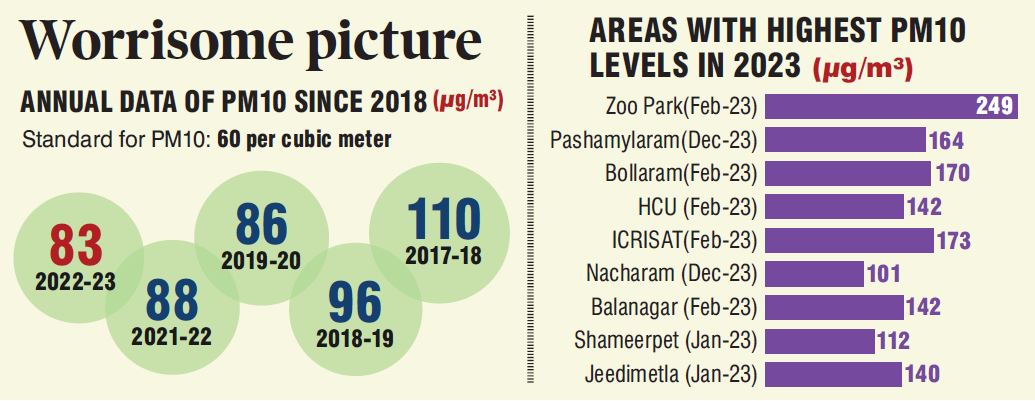The annual PM10 levels for Hyderabad have surpassed the permissible limit, painting a worrisome picture of the city’s air quality
Published Date – 21 January 2024, 11:15 PM

Hyderabad: Hyderabad faces a growing threat of pollution that lurks in the air its residents breathe. The city’s air quality, particularly the levels of PM10, has emerged as a critical issue.
The data released by PRANA, the Portal for Regulation of Air Pollution in Non-Attainment Cities, under the National Clean Air Programme (NCAP), underscores a persistent challenge. The annual PM10 levels for Hyderabad have surpassed the permissible limit, painting a worrisome picture of the city’s air quality.
According to PRANA’s records, the PM10 concentration for the year 2022-23 stood at 83 micrograms per cubic meter, a slight improvement from the previous year but still significantly higher than the acceptable standard of 60 micrograms per cubic meter. The trend over the years reveals that in 2021-22, it was recorded at 88 micrograms per cubic meter. In 2019-20, the levels were slightly lower at 86 micrograms per cubic meter. However, the data from 2018-19 showed a spike at 96 micrograms per cubic meter, while 2017-18 registered high levels at 110 micrograms per cubic meter.
PM10 particles, being minute enough to penetrate the respiratory system upon inhalation, pose severe health risks. These particles can cause detrimental effects on the heart and lungs, leading to respiratory issues, cardiovascular diseases, and other chronic health conditions, especially when exposure is prolonged.
The Centre for Research on Energy and Clean Air (CREA) released a report ranking cities based on PM10 concentrations from Continuous Ambient Air Quality Monitoring Stations (CAAQMS) in 2023. According to the findings, Hyderabad’s annual PM10 concentration was recorded at 85 micrograms per cubic meter. The report highlighted that for 79 days, the PM10 levels exceeded the Indian National Ambient Air Quality Standard, and for the entire year (365 days), it surpassed the World Health Organization (WHO) standard.
Additionally, Hyderabad’s annual PM2.5 concentration was reported at 38 micrograms per cubic meter. The report mentioned that for 2 per cent of the days, the PM2.5 levels exceeded the Indian National Ambient Air Quality Standard, while for the entire year (365 days), it surpassed the WHO standard.
Recent figures released by the Telangana State Pollution Control Board for various stations across the city reveal several areas consistently reporting PM10 concentrations above the permissible limit.
Balanagar reported levels ranging from 61 micrograms per cubic meter to 142 micrograms per cubic meter throughout the year. Uppal, Paradise, Charminar, and other areas consistently exhibited higher PM10 levels, frequently breaching the safety threshold.
Furthermore, the data from continuous ambient air quality monitoring stations (CAAQMS) and SAAQM Stations underscores the gravity of the situation.
Nehru Zoological Park, Pashamylaram, and Bollaram recorded high PM10 levels, surpassing 150 micrograms per cubic meter on numerous occasions, signifying a severe air quality crisis in these areas.



